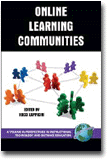
Online Learning Communities
Edited by:
Rocci Luppicini, University of Ottawa
A volume in the series: Perspectives in Instructional Technology and Distance Education. Editor(s): Charles Schlosser, Nova Southeastern University. Michael Simonson, Nova Southeastern University.
Published 2007
This book makes a contribution to the field of distance education by presenting key perspectives on the state of the field and examining and discussing specific current trends and issues faced by the distance learning community. To this end, the book brings together Quarterly Review of Distance Education’s most respected authors and other internationally known experts in the field of distance education to provide insight into a wide array of themes revolving around current work on communities of learning in distance education.
CONTENTS
Foreword, Sir John Daniel. A Focus on Online Learning Communities, Rocci Luppicini. PART I: PERSPECTIVES ON ONLINE LEARNING COMMUNITIES. Online Learning Communities in Perspective, Rena M.
Palloff and Keith Pratt. A Typology of Catalysts, Emphases and Elements of Virtual Learning Communities, Richard A. Schwier. Online Learning
Communities with Online Mentors: A Conceptual Framework, Shujen L. Chang. Foundations And Practice for Web-Enhanced Science Inquiry: Grounded
Design Perspectives, Minchi C. Kim and Michael J. Hannafin. PART II: DESIGN AND INSTRUCTION FOR ONLINE LEARNING COMMUNITIES. Designing Effective Online Instruction, Gary Morrision and Steven Ross. The Use of Discussion Forums in Learning Communities, Kinshuk and L.M.Jeffrey. Engaging and Supporting Problem Solving in Online Learning, David H. Jonassen. Laying The Groundwork for the Development of Learning Communities within Online Courses, Jennifer V. Lock. PART III: RESEARCH ON ONLINE LEARNING COMMUNITIES. Connections in Web-Based Learning Environments: A Research-based Model for Community Building, Janette R. Hill, Arjan Raven and Seungyeon Han. Identifying Factors That Effect Learning Community Development and Performance in Asynchronous Distance Education, Douglas Harvey, Leslie A. Moller, Jason Bond Huett, Veronica M. Godshalk, and Margaret Downs. Examining The Use of Learning Communities to Increase Motivation, Jason Bond Huett, Leslie A. Moller, Douglas Harvey, and Mary E. Engstrom. Linking Community Partners: Utilizing Video conferencing, Pamela A. Havice, William L. Havice, Clint Isbell, and Larry Grimes. PART IV: INTERNATIONAL PERSPECTIVES ON ONLINE LEARNING COMMUNITIES. Exploring Elements for Creating an Online Community of Learners within a Distance Education Course at The University of Southern Queensland, P.A. Danaher, Andrew Hickey,Alice Brown, and Joan M. Conway. Building Learning Communities Around New Partnership for Africa’s Development (Nepad) E-schools
Initiative, Peter E. Kinyanjui. International Perspectives on Distance Education and Learning Communities Within Anglophone Commonwealth Countries,
Badri N Koul. Orchestrating Ethics for Distance Education and Online Learning, Ugur Demiray. PART V: TRENDS IN ONLINE LEARNING COMMUNITIES. Online Self-organizing Social Systems: Four Years Later, David Wiley and Erin Brewer. Exploring Qualitative Methodologies in Online Learning Environments, Mary Beth Bianco and Alison A. Carr-Chellman. Revisiting Categories of Virtual Learning Communities for Educational Design, Rocci Luppicini. Contrasting Forces Affecting the Practice of Distance Education, Brent G. Wilson, Patrick Parrish, Nathan Balasubramanian, and Scott Switzer. About the Authors.
-
Paperback978-1-59311-678-1
Web price: $45.04 (Reg. 52.99)
-
Hardcover978-1-59311-679-8
Web price: $80.74 (Reg. 94.99)
- eBook9781607525981

-
 Beyond the Online Course
Leadership Perspectives on e-Learning
Beyond the Online Course
Leadership Perspectives on e-Learning
-
 Distance Education
Statewide, Institutional, and International Applications of Distance Education, 2nd Edition
Distance Education
Statewide, Institutional, and International Applications of Distance Education, 2nd Edition
-
 Distance Education
Statewide, Institutional, and International Applications of Distance Education
Distance Education
Statewide, Institutional, and International Applications of Distance Education
-
 Learning From Media 2nd Ed.
Arguments, Analysis, and Evidence
Learning From Media 2nd Ed.
Arguments, Analysis, and Evidence
-
 Real-Life Distance Education
Case Studies in Practice
Real-Life Distance Education
Case Studies in Practice
-
 Research on Course Management Systems in Higher Education
Research on Course Management Systems in Higher Education
-
 Trends and Issues in Distance Education 2nd Edition
International Perspectives
Trends and Issues in Distance Education 2nd Edition
International Perspectives

